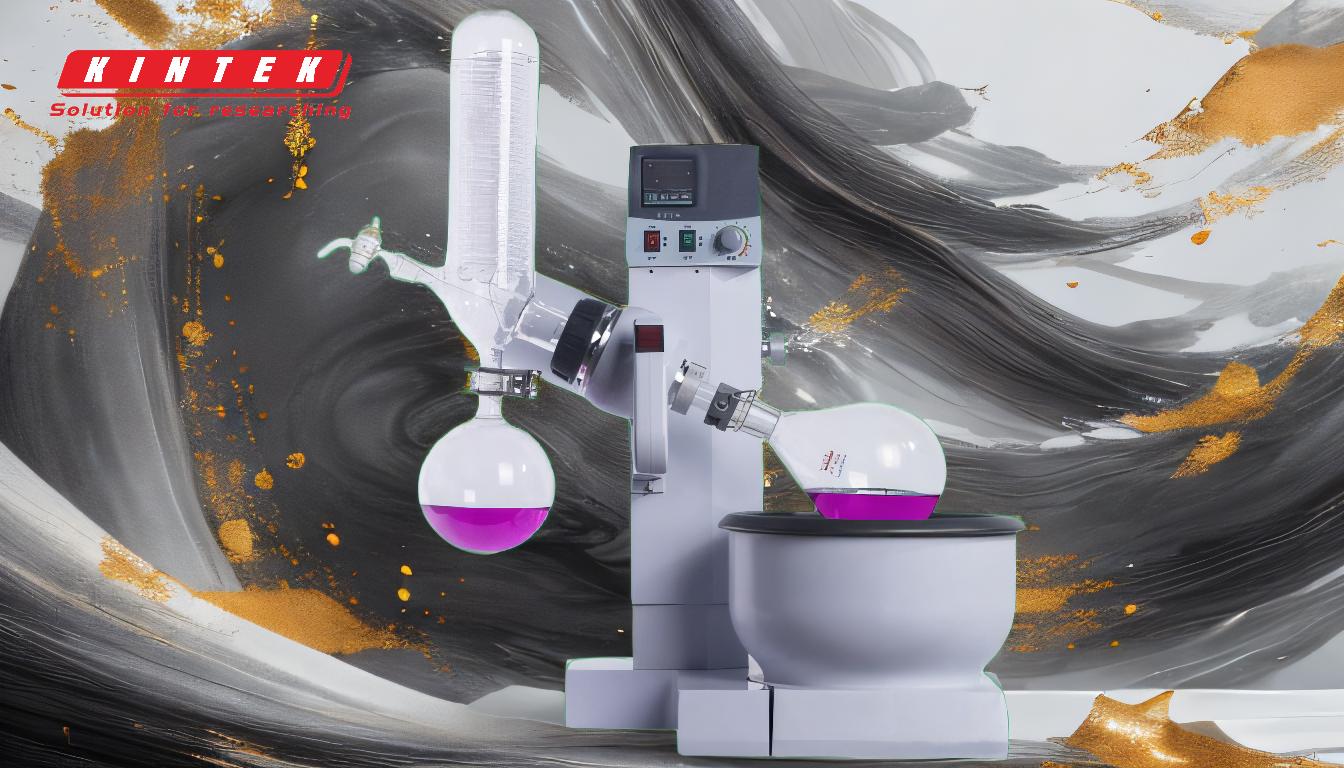Rotary evaporation and distillation are both separation techniques, but they differ significantly in their mechanisms, applications, and outcomes. Rotary evaporation is a gentler method that uses reduced pressure (vacuum) to lower the boiling point of solvents, allowing for evaporation at lower temperatures. This process is ideal for preserving heat-sensitive compounds and is commonly used in food, pharmaceutical, and chemical industries. In contrast, traditional distillation focuses on concentrating specific components, such as alcohol, by boiling and condensing vapors at higher temperatures. Rotary evaporation retains the residue (concentrated compound) in the original flask, while distillation retains the distillate (condensed vapor). Below, the key differences are explained in detail.
Key Points Explained:

-
Mechanism of Separation:
-
Rotary Evaporation:
- Operates under reduced pressure (vacuum), which lowers the boiling point of the solvent.
- Uses rotation of the evaporating flask to increase the surface area of the liquid, promoting faster and more even evaporation.
- Designed for solvent removal, particularly for low-boiling solvents.
-
Distillation:
- Relies on heating the mixture to its boiling point, causing the vaporization of components.
- Condenses the vapor back into liquid form (distillate) for collection.
- Focuses on concentrating specific components, such as alcohol or essential oils.
-
Rotary Evaporation:
-
Temperature Sensitivity:
-
Rotary Evaporation:
- Works at lower temperatures due to the vacuum, making it suitable for heat-sensitive compounds like flavors, fragrances, and pharmaceuticals.
- Prevents oxidation and degradation of delicate compounds.
-
Distillation:
- Requires higher temperatures to achieve boiling, which can alter or degrade heat-sensitive substances.
- More suitable for robust compounds that can withstand higher temperatures.
-
Rotary Evaporation:
-
Outcome and Retention:
-
Rotary Evaporation:
- Retains the residue (concentrated compound) in the original flask.
- The solvent is removed and typically discarded.
-
Distillation:
- Retains the distillate (condensed vapor) as the desired product.
- The residue may be discarded or further processed.
-
Rotary Evaporation:
-
Applications:
-
Rotary Evaporation:
- Ideal for extracting and concentrating flavors, fragrances, and active pharmaceutical ingredients (APIs) without altering their chemical structure.
- Commonly used in food science, perfumery, and organic chemistry labs.
-
Distillation:
- Primarily used for purifying liquids, such as alcohol, essential oils, and water.
- Widely applied in industries like beverage production, petrochemical refining, and wastewater treatment.
-
Rotary Evaporation:
-
Efficiency and Speed:
-
Rotary Evaporation:
- Faster evaporation due to increased surface area from flask rotation and reduced pressure.
- Promotes stable and even evaporation, reducing the risk of bumping or splashing.
-
Distillation:
- Slower process, as it relies on natural boiling and condensation cycles.
- May require additional steps, such as fractional distillation, to achieve higher purity.
-
Rotary Evaporation:
-
Equipment Design:
-
Rotary Evaporation:
- Includes a rotating flask, vacuum pump, condenser, and collection flask.
- Designed for precise control over pressure and temperature.
-
Distillation:
- Consists of a boiling flask, condenser, and collection flask.
- Simpler setup but less control over temperature and pressure.
-
Rotary Evaporation:
-
Preservation of Compounds:
-
Rotary Evaporation:
- Preserves the integrity of heat-sensitive compounds by operating at lower temperatures.
- Minimizes the risk of chemical alteration or degradation.
-
Distillation:
- May alter or degrade sensitive compounds due to higher operating temperatures.
- Better suited for compounds that are stable at elevated temperatures.
-
Rotary Evaporation:
In summary, rotary evaporation and distillation serve different purposes and are chosen based on the specific requirements of the separation process. Rotary evaporation excels in preserving delicate compounds and removing solvents efficiently, while distillation is better suited for purifying and concentrating robust substances. Understanding these differences helps in selecting the appropriate technique for a given application.
Summary Table:
| Aspect | Rotary Evaporation | Distillation |
|---|---|---|
| Mechanism | Uses vacuum to lower boiling point; rotates flask for even evaporation. | Relies on heating to boiling point; condenses vapor into liquid. |
| Temperature | Lower temperatures, ideal for heat-sensitive compounds. | Higher temperatures, suitable for robust compounds. |
| Outcome | Retains residue (concentrated compound) in the flask. | Retains distillate (condensed vapor) as the product. |
| Applications | Food, pharmaceuticals, fragrances; preserves delicate compounds. | Alcohol, essential oils, water purification; concentrates specific components. |
| Efficiency | Faster due to vacuum and rotation; reduces bumping or splashing. | Slower; may require fractional distillation for higher purity. |
| Equipment | Rotating flask, vacuum pump, condenser, collection flask; precise control. | Boiling flask, condenser, collection flask; simpler setup. |
| Preservation | Preserves heat-sensitive compounds; minimizes degradation. | May alter sensitive compounds; better for stable substances. |
Need help choosing the right separation technique? Contact our experts today!









